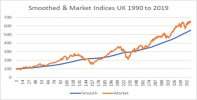Colm Fagan
Registered User
- Messages
- 763
Hi @Zion2022. Fantastic post.
The answer is that my approach only works for auto-enrolled pensions, and with the constraints set out in the paper in relation to how much and when members can contribute and withdraw funds That restricts the scope considerably. For example, it excludes people who don’t work for a wage or salary, it excludes the portion of people’s earnings which is highly discretionary (the low upper limit on qualifying earnings is an important element). The low upper earnings limit also limits the scope for more affluent workers who can decide when to ‘retire’ to play the system, etc. All these requirements- and others in similar vein - ensure that smoothing will never take over the world. What it will do is allow lower paid workers compete in investment terms with their richer colleagues- and win.
The answer is that my approach only works for auto-enrolled pensions, and with the constraints set out in the paper in relation to how much and when members can contribute and withdraw funds That restricts the scope considerably. For example, it excludes people who don’t work for a wage or salary, it excludes the portion of people’s earnings which is highly discretionary (the low upper limit on qualifying earnings is an important element). The low upper earnings limit also limits the scope for more affluent workers who can decide when to ‘retire’ to play the system, etc. All these requirements- and others in similar vein - ensure that smoothing will never take over the world. What it will do is allow lower paid workers compete in investment terms with their richer colleagues- and win.

